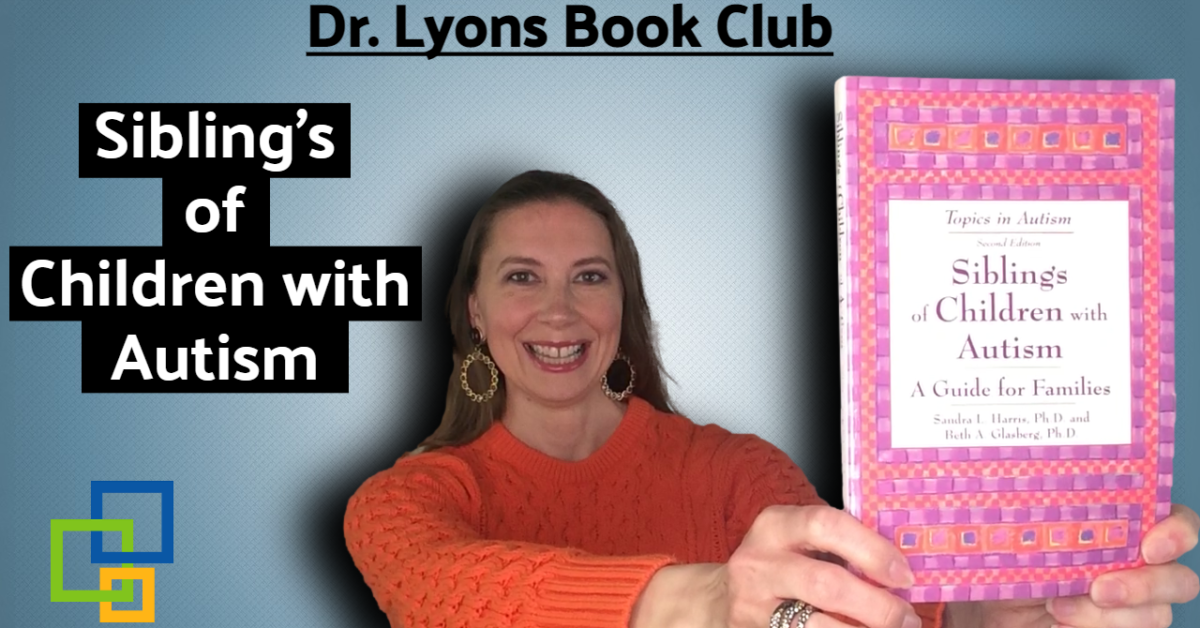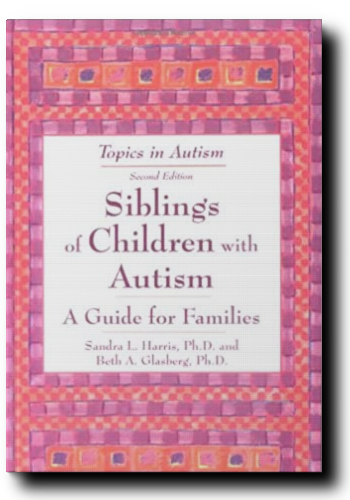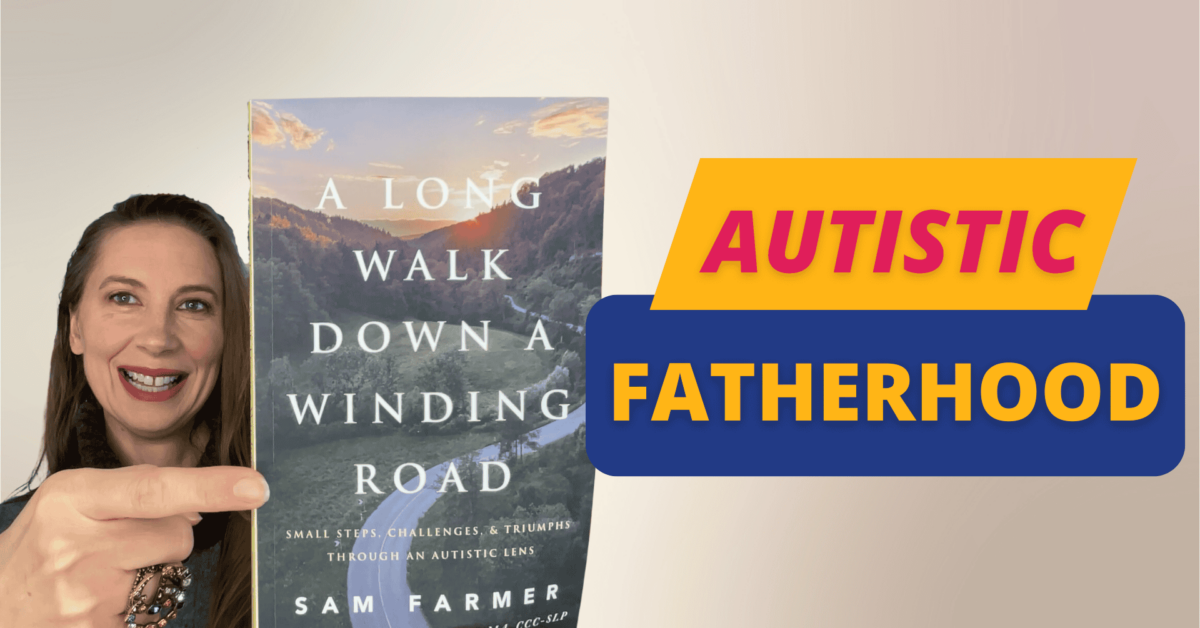What do you say to your other children about your child who has autism?
Sometimes it’s a tough discussion, right? Is there a right answer? Is there a wrong answer?
Even if you have an only child, this book will be relevant to you. So whenever I’m talking about siblings, just replace that word either with cousins, neighborhood kids, schoolmates. This has a lot of good information that can really be applied to more than just siblings.
Siblings of Children With Autism
-A Guide for Families-
-Sandra L. Harris, -Beth A. Glasberg
Introduction
This is definitely a quick read. It is very accessible and it has seven chapters.
The first one is just kind of a summary, second is a bit more clinical. So it talks about childhood development and it’s much more clinical in that aspect. But the third chapter has some great ideas and there’s a lot of quotes in here from other parents as to how they handled certain situations. I really like this book in the sense that it gives that clinical information. But then, we all know about theory, right? Then it gives practical information as well. So definitely a good book that gives you both perspectives. And I think both perspectives are really needed. I’ll pull out five really relevant sections of this book and share them with you.
What Do Your Children Think about Autism?
The first section is called What Do Your Children Think about Autism? And it says here:
“Make autism as accessible to discuss as what will be served for dinner. Try to jump in and offer brief concrete examples of any unusual behaviors or treatments. Even before your child asks, model your own confusion. For example, don’t be afraid to say out loud that you wish you knew if your preschooler would ever attend the same school as your typically developing child. But you just don’t know.”
Honesty is so important.
“While you don’t want to allow autism become a constant topic permeating all discussions, you also want to ensure that your children have someplace to turn with their questions and feelings.”
And yes, your other children, I’m sure, have lots of questions. They want to know what’s going on. And those questions change according to their age. And the book definitely goes into more ideas and more ways to handle those questions for age appropriateness. So if you’re looking for, you know, how do I tell my three-year-old that my seven-year-old has autism and, you know, how do I do that all throughout the growing-up process?
This definitely would be a good book for you. And it does give some general tips:
“Hear your child out through their whole explanation before correcting any errors. Stay neutral regardless of what you hear. Remember not to judge your child’s answers.”
And your other children are going to have emotions. The idea is to really create that safe environment so that they can express whatever they’re thinking, whatever they’re feeling. And a lot of times, as you know, we just need to vent.
If your other child is having some type of frustration, creating that safe environment for them to vent and not judging them or correcting them at that moment, is certainly something that this book advises. And then it goes on to say:
“Be sure to praise your child for sharing her feelings with you and acknowledge that you understand where any misconceptions about autism may have come from.” Another tip here is, “Keep in mind that you want your child to feel comfortable speaking with you again!”
Autism, it’s going to be a topic throughout their childhood, so you definitely don’t want this to be like, all right, we’ve had this conversation once. That’s it. No, there’s going to be a lot of things that come up all throughout childhood.
“Be prepared for your child to share intense emotions ranging from sympathy to guilt to anger.” And, yeah, you’re going to experience all those emotions, probably yourself. And then, of course, your children, also your child with autism is going to experience a whole bunch of emotions as well. So these tips really apply for everyone, both the parent, the child who doesn’t have autism and the child with autism.
And so it goes on in the book to say that for the young child, it’s important to keep explanations simple. I’ll just pull out a paragraph here:
“Explanations will be of relatively little use to a young child, but concrete intervention may help. For example, if your son is frightened by his sister’s tantrums, he must be comforted and reassured. Later if he can be encouraged to play simple games like rolling a ball to his sister. And if he enjoys the game, that will be good for both children. The fact that his sister has autism has no meaning to two or three-year-old child.”
And your other child is going to experience a lot of emotions, right? If your child with autism has some type of tantrum, a meltdown, sometimes those situations are really scary for the child with autism. It’s really scary for the parent. Of course, it’s scary. But for the other children, it’s scary as well. They might feel really helpless. I’m sure they love their sibling quite a bit. So there’s definitely a lot of emotions. But encouraging that bond when things are calm certainly goes a long way. And I know easier said than done. Right?! But it’s possible the book does go into some tips as to how to get siblings to play.
Talking Openly
And so this is a section where a parent is actually describing some things. Let me quote it.
“I firmly believe that if Tommy had been born without autism, my children would have had a vastly different childhood.”
“Be that as it may, the suggestion I have for other parents is to be there for them and to talk to them openly about their feelings, whether bad or good, concerning their sibling with autism. We as parents have shared all of our trials and tribulations concerning Tommy with our other children. We have encouraged them to voice their opinions when they wanted to. This, in turn, has made them feel a very important part of Tommy’s life, and that has helped ease the stress in many situations.”
“I believe that as long as a family is open and honest with each other, they can get through almost any situation. Tommy is the prime topic of conversation in our home, and no matter how the children are feeling about him that day, they express those feelings. Sometimes the problem isn’t completely resolved, but at least they know we are here to listen and to try and help whenever we can.”
And that’s so important. Problems aren’t always resolved, at least, you know, immediately. But feeling heard can just go so far in having that family bond.
Together or Apart?
This topic is definitely a hot topic and it’s called together or apart. And you might have struggled with this, do I try and take my child with autism to all the advance of my other children? You know, there’s only one of you! So you can’t be everywhere, right? If you have three, four or five children, you can’t be at every single thing.
So the question is, do you try and bring your child with autism to everything that you’re trying to do. This can get very stressful. So here, the book says:
“Although we respect the idea that everyone in the family should share family events, we believe it is important to think flexibly about who should be included in an event. If one child has a concert and your child with autism is not able to sit quietly through the music, we believe it is usually more important for the parents to go to the concert by themselves than it is to include the child with autism and risk disrupting an important moment for the other child. Every child needs a chance to shine, and sometimes a sibling with autism can cast a shadow that never allows another child to be the center of attention.”
It’s a difficult situation. It really is. And sometimes it’s important to have this type of discussion to come up with a plan, to negotiate things, to make sure everyone feels heard, including your child with autism. So if they can’t sit and be quiet and that’s really what the situation calls for and it might be best for them to stay at home so that your other child can feel really important and special that day and have all of that attention. It’s a give and take. It’s being in the family. So having these types of discussions and resolving guilt that might be in your own mind, that will go so far. And I know these are not easy decisions to make. They’re not. That’s why it’s good to plan it out, to have some type of strategy, to make these decisions when you’re level-headed and when you’re not feeling emotional or angry or stressed or anything like that.
Playing Together
Alright, and this last part is about getting siblings to play together. Sometimes that is just hard in and of itself. Right. I know my brothers, we definitely did not play well together at all times. So how much effort do you want to put into trying to have your siblings play together? Here’s a quote from a parent:
“When I first started to get my kids to play together, I wondered if it was more work than it was worth.”
“Eric, my boy with autism can be a tough cookie, and he could really give my daughter Sarah a hard time. For a long time, I pretty much had to sit there and watch so that I could pick Eric up and put him in timeout if he got rowdy. But gradually he started to enjoy being with Sarah and now it is rare that he gets out of control. When he does, Sarah knows to call me and I put him in a timeout.”
“It took three or four months to get it rolling, but now it works pretty well.” And that last sentence is super important. Sometimes we have these great ideas, sometimes it’s almost like a dream that I wish this could happen and you start taking action towards it. It might take three or four months until it actually succeeds, sometimes maybe even longer.
But the important thing is to keep at it. Your child with autism definitely wants to be involved. Your children that don’t have autism, want to be involved and have that family sense. And so do you. Everybody has that desire.
It just sometimes doesn’t work out, but don’t give up.
I certainly recommend this book. This is a very good resource for really everybody, whether you have other children or not. You’re going to have other kids who are going to ask about your child. And this really helps prepare for different conversations so that when people ask you questions, those questions don’t stress you out.





